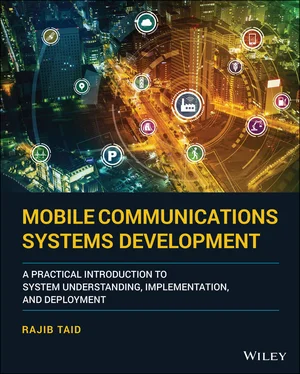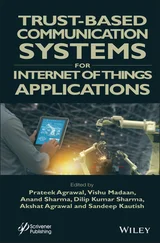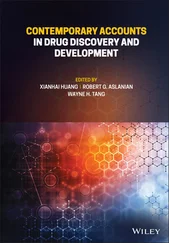There are large numbers of technical specifications, or standards, for different areas of the mobile communications networks based on the GSM, GPRS, UMTS, LTE, and 5G technologies. Those technical specifications cover the different system engineering aspects of a mobile communications network as described in Section 2.4. Technical specifications of related protocols or subject areas (e.g. signaling, service aspects) of a particular mobile technology are grouped into so‐called “ specification series ” , for example, 3GPP TS 44 series, 24 series specifications, and so on. Within a particular series, all the technical specifications of a related protocol or protocol stack can be found.
Visit the 3GPP site [2] for the lists of technical specifications series that are available in each of the mobile communications technologies, such as GSM, GPRS/EDGE, UMTS, LTE, and 5G (second, third, fourth column) under a particular subject area (first column). The specification is organized into the following categories:
3G (UMTS) and beyond/GSM (R99 and later), covering the 5G also;
GSM only (Release‐4 and later); and
GSM only (before Release ‐4).
Start with and look at the standard specification(s) for a particular mobile communications technology domain (column (2) or (3) or (4)) of your interest. For the complete list of the technical specification series, the reader is advised to visit the 3GPP site [2]. Note that after Release 4 or R4, the old GSM specification numbers are increased by 40 (second column from right in [2]), whereas the UMTS standards or specification numbering is lowered by 20 numbers (second column from left in the table appearing on this web site page) corresponding to each GSM standard. Thus, the GSM standard 01.0x has now become GSM 41.00x and UMTS 21.xxx. Note that technical specifications of a particular mobile communication technology such as GSM, EDGE, UMTS, LTE, or 5G could span across multiples series. For example, LTE and 5G have the dedicated specifications series, i.e. 36 and 38; see the 3GPP site [2]. However, one can also find LTE protocol layer‐related specifications/information in other series such as the TS 24.008[45].
Version, Release Number of a 3GPPTechnical Specification
Each 3GPP technical specification has its version number in the form of a.b.c . The meanings are as follows:
a
This is the release field. It is incremented each time a major new functionality is added to the concerned mobile communication technology area such as GSM, GPRS/EDGE, UMTS or 5G system.
b
This is the technical field. It is incremented each time a technical change is made to the concerned technical specification. Note that the technical information field is reset to zero every time the release field is updated.
c
This is the editorial field. It is incremented each time an editorial change is made to a specification. Note that it is reset to zero every time the technical field is updated. For example, TS 44.060 V6.0.0 means that it belongs to 3GPP Release 6. Open a technical specification and have a look at the meaning of each number. One should consider referring to a specification having the first digit of the version as 3 and above because that is the version of the specification under change control. More about the version numbering scheme could be found by visiting the 3GPP site link [5].
2.5.7 Vocabulary of 3GPP Specifications
For a list of glossaries of terms, their definition, and the abbreviations as found in various 3GPP specifications as well as in this book, refer to the 3GPP TR 21.905 [24].
2.5.8 Examples in a 3GPP Technical Specification
3GPP technical specifications are full of theories, and one will not find, except in some cases, virtually illustrating examples in any technical specifications. This may make the reader difficult to grasp a particular concept at the first go. In this case, it is highly recommended to study the contents of a particular message or a TS several times. The reader may take the help of an experienced professional/colleague in this regard.
2.5.9 Standardization of Technical Specifications by 3GPP
Standardizations of technical specifications are required and important to design interoperable systems by different vendors/OEMs. Because of standardizations, one can use various telecommunications services from different service providers using varieties of handheld devices such as Mobile and POS terminal.
2.5.10 Scope of 3GPP Technical Specification (TS)
A particular 3GPP technical specification description may cover all the systems. A TS specifies its applicability/scope to other mobile communications systems such as the GERAN, UMTS, LTE, and 5G. Pay attention to this fact. For example, click on any specification series for a particular subject area on the 3GPP site [2]. All the technical specifications shall be presented under that particular series. Now, further, click on any technical specifications. A new window shall be opened, and from there, one can find the scope and applicability, under Radio Technology , of the technical specification being clicked. Below the Radio Technology , there is a link by clicking which all the versions/releases of the particular technical specification can be downloaded.
The first section of every technical specification also describes its scope. Moreover, the first page of every technical specification displays the GSM or LTE or LTE Advanced or 5G logo depending on the scope.
2.5.11 3GPP TS for General Description of a Protocol Layer
A 3GPP protocol layer may perform several important functions and procedures. The functions and procedures performed may be split into several individual technical specifications. For such a protocol layer, it contains an introductory technical specification too, for example, LTE TS 36.201 [89] and 5G NR TS 38.201 [105], which provides an overview and a general description of the concerned protocol layer. The introductory technical specification also describes the detailed relationships among the split technical specifications. It may be also noted that for the same protocol layer, for example, in the case of the UMTS physical layer, there may be separate technical specifications depending on its duplexing modes, i.e. Frequency Division Duplex (FDD) and Time Division Duplex (TDD), of transmission which is used by the physical layer.
However, in the LTE and 5G NR system, no separate technical specification is used to describe the physical layer functions and procedures working in the TDD and FDD mode.
2.5.12 3GPP TS Drafting Rules: Deriving Requirements
To derive various technical, functional, and other requirements without any ambiguity, the contents of a 3GPP technical specification should be understood and decoded properly. A 3GPP technical specification description contains the following types of requirements.
Normative
Such requirements must be complied with.
Informative
Such requirements if ignored, it does not matter. Note that a technical report is always an informative one.
To identify the above requirement types, a 3GPP specification/text description may contain the following auxiliary verbs:
Shall/Shall not – This is a normative and implies a mandatory requirement.
May/Need not – This is a normative and optional requirement.
Should/Should not – This is a normative and Recommendation requirement.
Can/Cannot – This is a normative and possibility/capability requirement.
Also, a 3GPP technical description is described using an active voice rather than a passive voice. For example, “ The MS shall perform…” rather than the “ …routing area update shall be performed by the MS”.
Читать дальше












